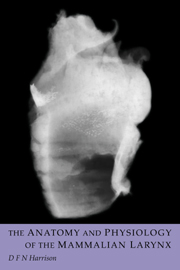3 - General aspects of laryngeal morphology
Published online by Cambridge University Press: 05 October 2010
Summary
It is widely accepted that the larynx evolved around the time that the respiratory system changed from gills to lungs. The earliest larynx consisted of a cartilaginous plate suspended from the vertebral column, as is found Protopterusy the lung fish. With increasing muscular activity, a more dynamic system was needed to provide a wider opening to the lungs and bilateral movable cartilages developed along the sides of the air passage. Sphincteric muscles wrapped around these lateral cartilages provided a means of closing the entrance to the lungs. Later, these fused to form the cricoid ring carrying or articulating with arytenoids on its upper surface. The more developed species formed a protective thyroid cartilage which ultimately articulated independently with the cricoid; this being the basic design of all present day mammalian larynges (Negus, 1949). Although this is so, morphological variations are common, being related in part to life-style and particularly dietary needs.
Most mammals have a well developed epiglottis protruding into the nasopharynx thereby enhancing olfaction and allowing respiration during feeding. The vocal cords vary in length and although arytenoids, corniculate and cuneiform cartilages are usually present, their size and shape depends upon the age and species of the animal. Large arytenoids surmounted by large corniculate cartilages provide a high posterior wall to the larynx, allowing masticated food to flow to the stomach by way of lateral channels on either side of the glottis.
- Type
- Chapter
- Information
- The Anatomy and Physiology of the Mammalian Larynx , pp. 30 - 47Publisher: Cambridge University PressPrint publication year: 1995
- 1
- Cited by



